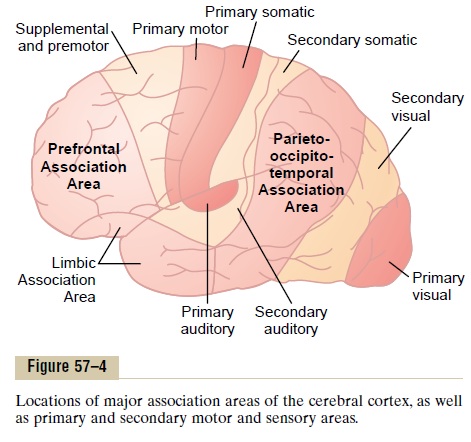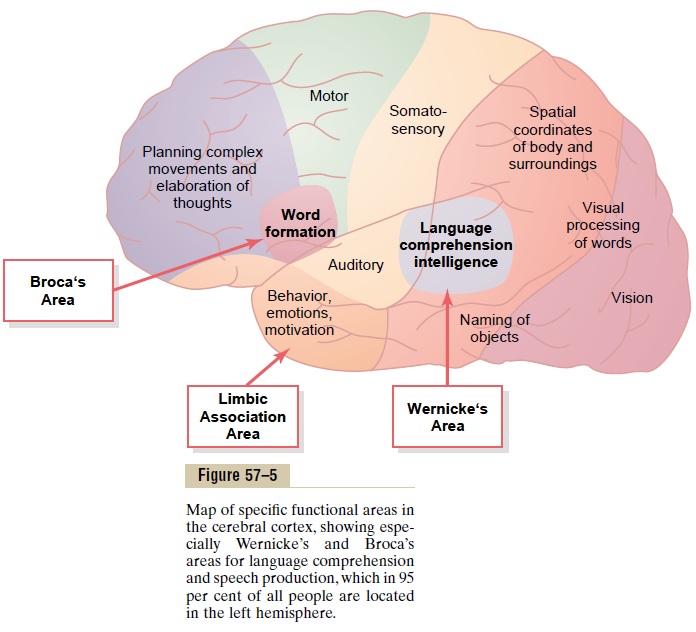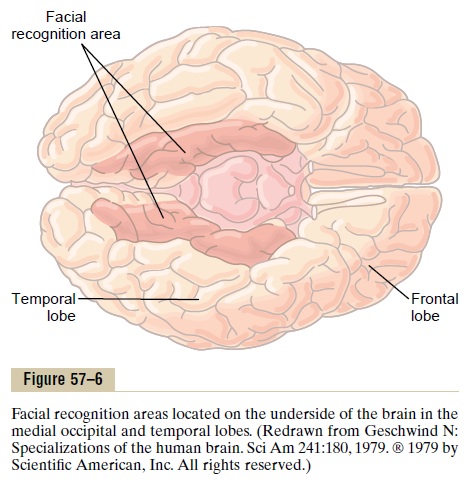Chapter: Medical Physiology: Cerebral Cortex, Intellectual Functions of the Brain, Learning and Memory
Association Areas - Functions of Specific Cortical Areas
Association Areas
Figure 57–4 also shows several large areas of the cere-bral cortex that do not fit into the rigid categories of primary and secondary motor and sensory areas. These areas are called association areas because they receive and analyze signals simultaneously from multiple regions of both the motor and sensory cortices as well as from subcortical structures. Yet even the association areas have their specializations. The most important association areas are (1) the parieto-occipitotemporalassociation area, (2) the prefrontal association area,and (3) the limbic association area. Following are explanations of the functions of these areas.

Parieto-occipitotemporal Association Area. This associationarea lies in the large parietal and occipital cortical space bounded by the somatosensory cortex anteri-orly, the visual cortex posteriorly, and the auditory cortex laterally. As would be expected, it provides a high level of interpretative meaning for signals from all the surrounding sensory areas. However, even the parieto-occipitotemporal association area has its own functional subareas, which are shown in Figure 57–5.

1. Analysis of the Spatial Coordinates of the Body. Anarea beginning in the posterior parietal cortex and extending into the superior occipital cortex provides continuous analysis of the spatial coordinates of all parts of the body as well as of the surroundings of the body. This area receives visual sensory informa-tion from the posterior occipital cortex and simulta-neous somatosensory information from the anterior parietal cortex. From all this information, it computes the coordinates of the visual, auditory, and body surroundings.
2.Area for Language Comprehension. The major areafor language comprehension, called Wernicke’s area, lies behind the primary auditory cortex in the posteriorpart of the superior gyrus of the temporal lobe. Wediscuss this area much more fully later; it is the most important region of the entire brain for higher intel-lectual function because almost all such intellectual functions are language based.
3.Area for Initial Processing of Visual Language (Reading). Posterior to the language comprehensionarea, lying mainly in the anterolateral region of the occipital lobe, is a visual association area that feeds visual information conveyed by words read from a book into Wernicke’s area, the language comprehen-sion area. This so-called angular gyrus area is needed to make meaning out of the visually perceived words. In its absence, a person can still have excellent language comprehension through hearing but not through reading.
4.Area for Naming Objects. In the most lateral por-tions of the anterior occipital lobe and posterior tem-poral lobe is an area for naming objects. The names arelearned mainly through auditory input, whereas the physical natures of the objects are learned mainly through visual input. In turn, the names are essential for both auditory and visual language comprehension (functions performed in Wernicke’s area located imme-diately superior to the auditory “names” region and anterior to the visual word processing area).
Prefrontal Association Area. We learned that the prefrontal association area functions in close association with the motor cortex to plan complex patterns and sequences of motor movements. To aid in this function, it receives strong input through a massive subcortical bundle of nerve fibers connecting the parieto-occipitotemporal association area with the prefrontal association area. Through this bundle, the prefrontal cortex receives much preanalyzed sensory information, especially information on the spatial coordinates of the body that is necessary for planning effective movements. Much of the output from the prefrontal area into the motor control system passes through the caudate portion of the basal ganglia-thalamic feedback circuit for motor planning, which provides many of the sequential and parallel compo-nents of movement stimulation.
The prefrontal association area is also essential tocarrying out “thought” processes in the mind. This pre-sumably results from some of the same capabilities of the prefrontal cortex that allow it to plan motor activ-ities. It seems to be capable of processing nonmotor as well as motor information from widespread areas of the brain and therefore to achieve nonmotor types of thinking as well as motor types. In fact, the prefrontal association area is frequently described simply as important for elaboration of thoughts, and it is said to store on a short-term basis “working memories” that are used to combine new thoughts while they are entering the brain.
Broca’s Area. A special region in the frontal cortex,called Broca’s area, provides the neural circuitry forword formation. This area, shown in Figure 57–5, islocated partly in the posterior lateral prefrontal cortex and partly in the premotor area. It is here that plans and motor patterns for expressing individual words or even short phrases are initiated and executed. This area also works in close association with Wernicke’s language comprehension center in the temporal association cortex.
An especially interesting discovery is the following: When a person has already learned one language and then learns a new language, the area in the brain where the new language is stored is slightly removed from the storage area for the first language. If both languages are learned simultaneously, they are stored together in the same area of the brain.
Limbic Association Area. Figures 57–4 and 57–5 show stillanother association area called the limbic associationarea. This area is found in the anterior pole of the tem-poral lobe, in the ventral portion of the frontal lobe, and in the cingulate gyrus lying deep in the longitu-dinal fissure on the midsurface of each cerebral hemisphere. It is concerned primarily with behavior,emotions, and motivation. We will learn that the limbic cortex is part of a much more extensive system, the limbic system, that includes a complex set of neuronal structures in the midbasal regions of the brain. This limbic system provides most of the emo-tional drives for activating other areas of the brain and even provides motivational drive for the process of learning itself.
Area for Recognition of Faces
An interesting type of brain abnormality called prosophenosia is inability to recognize faces. Thisoccurs in people who have extensive damage on the medial undersides of both occipital lobes and along the medioventral surfaces of the temporal lobes, as shown in Figure 57–6. Loss of these face recognition areas, strangely enough, results in little other abnor-mality of brain function.

One wonders why so much of the cerebral cortex should be reserved for the simple task of face recog-nition. Most of our daily tasks involve associations with other people, and one can see the importance of this intellectual function.
The occipital portion of this facial recognition area is contiguous with the visual cortex, and the temporal portion is closely associated with the limbic system that has to do with emotions, brain activation, and control of one’s behavioral response to the environ-ment.
Related Topics